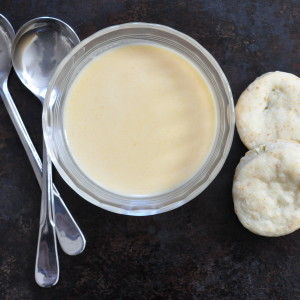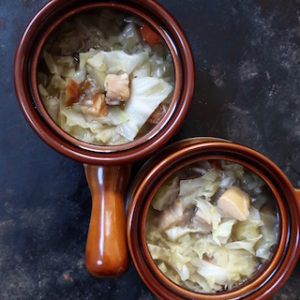Cream of Turnip Soup
Turnips have a reputation for harsh, biting flavor. While larger, mid-winter specimens are indeed pretty sharp, requiring long cooking to soften them, the Tokyo turnip is smaller, gentler, and mildly flavored. Simmered into a soup with potato and cream, it is amiable and surprisingly sweet.

I confess to modeling my turnip soup on another favorite soup: Paula Wolfert’s Autumn Squash Soup, which appears in The Cooking of Southwest France. To this end, I tossed a pig’s foot into the pot. The soup may also be made with a piece of pancetta, ham, leftover chicken, or be left entirely vegetarian. And while I used chicken broth, vegetable broth or water will work, too, though the soup will have less depth.

Lacking exciting photos of chicken broth, I give you chicken eggs, leading to the never-ending conundrum: which came first?
Do include potatoes, which give body, and carrot, for color, flavor, and nutritional value.

A shot of brandy or Madeira is optional. The alcohol will cook off.

Above: the only time in memory I went to San Francisco’s Union Square, a high-end shopping district, in the hopes of refreshing my pandemic-depleted wardrobe, and returned empty-handed. The store shelves are indeed sadly depleted….those stores that are still open. A sad sight it was.

Other optional additions to the soup include a small amount of hot pepper or hot paprika, sliced ham, and, at the table, sharp cheddar cheese. Good bread or the cheddar cheese muffins from the last post pair well, too. If this is too much Cheddar for you, crusty bread, like the little black dress, never go amiss.

Cream of Turnip soup is everything holiday eating is not: calm, smooth, enjoyable, digestible. Yes, there’s cream, but there are vegetables, too. It is filling without leaving you feeling stuffed or rummaging for that bottle of indigestion meds. Further, cream of turnip soup freezes well, so next week, when you find yourself staring down a dessicated turkey carcass, you will not be forced to make Turkey Tetrazzini.

(Shred the leftover meat and drop it in this soup. Voilà! Edibility!)
Cream of Turnip Soup
With credit to Paula Wolfert’s The Cooking of Southwest France
Prep Time: about 20 minutes
Cooking time: This depends on your vegetables; anywhere from one to two hours. The soup may also be left to simmer over very low heat for several hours.
Please read notes, below, before beginning to cook
1 small onion, peeled and chopped
2-3 garlic cloves, peeled and smashed
1 bunch/approximately 9-10 ounces/280-300grams small turnips, peeled if necessary, washed and trimmed if not.
2 baking potatoes, peeled and chunked
1 or 2 carrots, peeled and sliced
2 tablespoons unsalted butter, for the pan
a little olive oil, for the pan
6 cups/1.5 L unsalted chicken broth, vegetable broth, or water
1 cup/480ml cream, milk, or other dairy
Salt and pepper to taste
Optional additions:
Sliced ham
A pinch of hot pepper flakes or hot paprika
A shot of brandy or Madeira
minced green onion, for the top
It is helpful to have an immersion blender, food processor, or conventional blender if you want to puree this soup. If you have none of these appliances, you can still make cream of turnip soup by using a potato masher to partially crush the vegetables. Or you can leave everything whole. The soup will still taste good.
Start with the vegetable prep:
Peel and chop the onion. Crush the garlic cloves.
If your turnips come with the greens, and they’re in good shape, cut them off and save them for another dish.
If your turnips are organic and their skins are thin, scrub them well and trim any bad spots. Cut into pieces.
If your turnips are older baseballs, peel and cut into pieces.
Peel and chunk the potatoes.
If your carrots are organic, just scrub them. If not, peel. Either way, cut into chunks.
In 8 quart/8L soup pot or comparable cooking vessel, melt a generous 2-3 tablespoons butter with a pour of olive oil over medium low heat. Once the butter is melted, add the onion, garlic, and carrot to the pan. Lower the heat a bit and allow the vegetables to simmer without browning for about five minutes, stirring occasionally.
Add the turnips, give everything a good stir, and cook a few minutes more. This part of the process gives you a better soup. I learned this from Diana Henry, who knows more about cooking than I ever will.
Add the potatoes, salt, pepper, and chicken broth (or whatever liquid you are using). Stir. The vegetables should be just covered; use your judgement. You can add more of whatever liquid you cooking with if you feel it necessary, or just add water.
Taste for seasoning before adding in your pork product, if using–you can’t taste the soup again until the pork is cooked.
Add your pork product now, if using.
Add brandy and hot pepper now, if using.
Bring soup up to a low simmer and keep it there, stirring now and then. Depending on your vegetables and your stove, cooking time will range from 60-90 minutes. If you wish, you can also turn the heat down, or put the pan on a flame tamer, and leave it to simmer all morning, or all afternoon, provided you check on it. I have warned you: do not burn your house down, or anyone else’s. The world is mess enough as it is.
The soup is ready when the vegetables are soft enough to crush easily with the side of a fork and the pork is cooked.
To add the cream and puree:
Remove pork to a bowl.
Remove soup from heat.
I use an immersion blender, and due to limited electrical outlets, must move the pan across the kitchen. CAREFULLY place the immersion blender in the soup pan, or pour slowly into the processor or blender.
Do not turn it on the immersion blender or off unless the blender stick is in the pot. I have done this. Learn from my mistakes.
I never blend soups in my processor, because I frankly don’t trust it to not to leak. I had a blender, but gave it away, as I never used it, and it took up space I don’t have.
Return the pureed soup to low heat.
If the pork has cooled enough to handle, shred or cut it up and place the meat in the soup pot.
To serve, ladle the soup into bowls and top with some or none of the following:
Thinly sliced ham
thinly sliced green onion
Serve Cream of Turnip Soup with a green salad, the Cheddar Cheese scones from last week’s post, crusty bread, or just by itself.
Cream of Turnip soup will keep, covered, in the refrigerator for three days. Beyond that, either reheat it to almost boiling before refrigerating again, or, ideally, freeze it up to three months.
Notes:
Turnips are by nature watery. If you want a thicker soup, add another potato.
Any allium will work here: shallots, small red onions, yellow onions, a leek.
If an entire cup of cream makes you shudder, 3/4 of a cup will suffice. Milk is fine, too, as is buttermilk. Yogurt will work, but to avoid splitting, pour off some soup into another bowl, allow it to cool, and stir the yogurt into this cooled soup. Pour this back into the pot.
In the United States, turnips are sold in markets both bunched, with greens, and loose, in bins, without their greens. The loose turnips, at least where I live, tend to be larger, older, and sharper tasting. If you want to use the greens in the soup, feel free. I wanted to, but the greens were past their prime and I could not.
The advent of social media has created a new and odd situation where we meet and befriend wonderful people while never actually meeting them in real life. So it was with my friend Jackie, who lived in England. A retired nurse, Jackie was a gifted seamstress who sewed many of her own outfits, and like so many Englishwomen of a certain age, cultivated an exquisite garden.
She was also the very rare person able to speak to me about my home situation in an understanding manner. Perhaps this came of her nursing career. Many people are at a loss when–if–they learn I am a caretaker for somebody with worsening neuromuscular disease while being increasingly ill myself. I understand that. I really do. I mean, what is there to say? Take turmeric? But when people who should know better say stupid things, it rankles. Just last week, while at the doctor’s office, a nursing assistant called me a hero. I am not a hero. I am a person in a terrible situation. And I said so.
Jackie never made remarks like that. She had a way of saying yeah, I’m in a bad way, but you’re in a really bad way for somebody your age.
She was in a worse way, because she got sick with cancer, and due to Covid, she couldn’t get the care she needed. She died two weeks ago. She was a good friend, even if I never “met” her, and I will miss her terribly.





